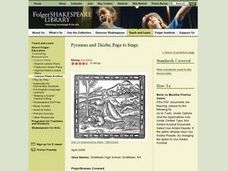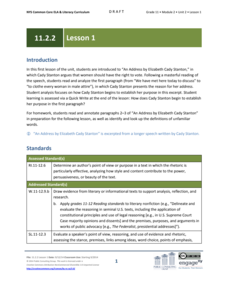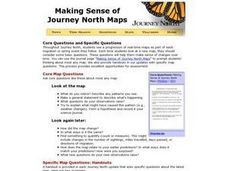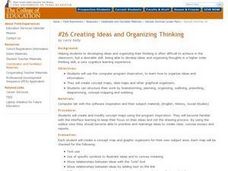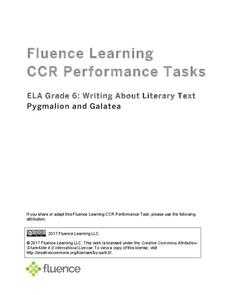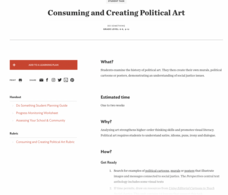Curated OER
Matching Pairs
Students examine the probability of the various findings in a game and determine the odds of winning. They differentiate between the facts of odds versus probability. Students use higher order thinking skills to explain how a problem is...
Curated OER
Technology Lesson Plan
Students measure various objects using non-standard units. The goal is for them to practice measuring in order to apply the physical act to various objects found in the classroom. The lesson is ideal for the kinesthetic learners and...
Curated OER
The Kansas and Nebraska Act
Students use a primary source of a political cartoon to set the context for a lesson. They answer key questions in writing or orally. Students conduct a class discussion about the issue to stimulate higher order thinking skills like...
Curated OER
Pyramus and Thisbe, Page to Stage
High schoolers read and interpret a script. Then they use higher order thinking skills to transfer information to long term memory. They use the information and interpretations in order to have a model to create dramatic scripts.
Curated OER
EARLY COLORADO ADVERTISING
Students investigate the history of advertising in Colorado.They analyze newspapers and advertisements putting them into different categories. Students question the content to develop higher order thinking skills.
Curated OER
Compass Rose Tossing
Young scholars use different pieces of equipment to practice throwing and catching. They use the cardinal directions of North, South, East and West in making a compass rose with the equipment. They must use higher order and decision...
Curated OER
Peter and the Starcatchers: QAR Strategy
Examine different types of questions while studying Peter and the Starcatchers. After learning about the different types of questions, pupils read passages from the text, answer the questions, and label each question with its...
California Academy of Science
The Heat is On: Cause and Effect and Climate
The higher the number of letters in the final word for the National Spelling Bee, the higher the number of people killed by venomous spiders. Obviously, those two facts correlate, but no causation exists. Scholars view data based on...
Illustrative Mathematics
Sale!
Everyone loves a sale, and this worksheet allows learners to calculate which sale is more rewarding. The activity can be adapted for different thinking contexts. The answer key describes different answer choices, some being higher...
EngageNY
Grade 11 ELA Module 2: Unit 2, Lesson 1
How did Elizabeth Cady Stanton use rhetoric to convince others of her views? Scholars begin reading "An Address by Elizabeth Cady Stanton," which argues that women should have voting rights. Pupils complete a Quick Write to analyze how...
Curated OER
Making Sense of Journey North Maps
Students use maps and answer core curriculum questions in order to increase comprehension and practice higher order thinking skills. This helps them develop writing skills through the practice of keeping Science Journals.
Curated OER
Basic Crypto Systems
Students try to solve codes mathematically. The use of a code needs a key. Students try to decipher a code with a mathematical key. This requires focus and higher order thinking skills like analysis.
Curated OER
Read Between the Lines
Build comprehension, inference, and conclusion skills by encouraging learners to see the importance of reading between the lines.
Curated OER
Creating Ideas and Organizing Thinking
Students examine the concept of developing ideas and organizing their thinking. They create concept maps and graphic organizers using Inspiration software, and develop a concept map for their own subject area.
Curated OER
The Thinking Approach to Reading
Students discover to how to tell what a passage is saying and different types of reading. They relate the situations to real life situations.
Novelinks
The Little Prince: Blooms’ Taxonomy Questions
Question what you read with a lesson based on Bloom's Taxonomy. As kids read The Little Prince by Antoine de Saint-Exupéry, they formulate questions with cues from a graphic organizer, and answer them to work on critical thinking skills.
Novelinks
Things Fall Apart: Bloom’s Taxonomy
Promote critical thinking and literary analysis with a short activity. Readers of Chinua Achebe's Things Fall Apart respond to a series of questions modeled on Bloom's Taxonomy.
Novelinks
The True Confessions of Charlotte Doyle: Cognitive Enhancement
Put your thinking cap on, it's quiz time! Here, scholars use their knowledge of the book, The True Confessions of Charlotte Doyle by Avi to create six questions to be used in their upcoming quiz.
Intel
Cell-to-Cell
The third in a series of 10 STEM project-based lessons focuses on cells types, functions, and physiology. Through research, discussions, writings, and presentations, groups learn about the difference between plant and animal cells, the...
Fluence Learning
Writing About Literature Shakespeare and Plutarch
The Oscar for the Best Adapted Screenplay acknowledges a writer's excellence in adapting material found in another source. What do your class members know about adapted resources? Find out with an assessment that asks readers to compare...
Fluence Learning
Writing About Literary Text: Pygmalion and Galatea
Is it crazy to fall in love with your own work, or is that the purest love of all? Compare two renditions of the classic Greek myth Pygmalion and Galatea with a literary analysis exercise. After students compare the similarities and...
Teaching Tolerance
Consuming and Creating Political Art
A picture is worth a thousand words, but political art may be worth even more! After examining examples of political cartoons, murals, and other forms of public art, class members create their own pieces to reflect their ideals and...
Intel
Using Electricity on the Job
Learners explore electricity, discussing its importance and researching different ways in which electricity can be generated. Groups present their findings to the class and then create publicity materials which promote and educate about...
Fluence Learning
Writing About Informational Text: Everybody Can Bike
A three-part assessment challenges scholars to read informational texts in order to complete three tasks. Following a brief reading, class members take part in grand conversations, complete charts, and work in small groups to research...





